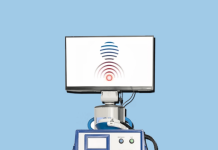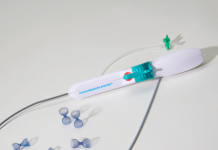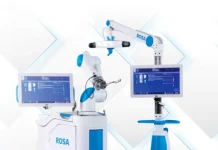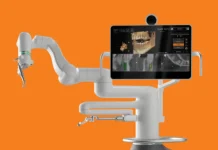- An innovative add-on feature for the 3D-Bioplotter, the PrintRoll platform was designed to enable 3D printing of cylindrical medical solutions for adults and children and therefore offers a range of standard and custom drum diameters
- The PrintRoll platform further solidifies the 3D-Bioplotter’s premier position in the field of bioprinting. Widely recognized as the world’s first commercial bioprinter1, the 3D-Bioplotter has enjoyed continuous improvements for 20+ years that make it a proven solution that scales from R&D to end-use part manufacturing
- The U.S. Food and Drug Administration (FDA) recently granted 510(k) clearance to Chicago-based Dimension Inx for its CMFlex™, a bone graft substitute regeneration product developed and manufactured on the 3D-Bioplotter
- Available in two models, the Developer and Manufacturer, 3D-Bioplotter offers modular functionality, such as eight different printheads, so users can enhance their printer for years after purchase with new features like PrintRoll
- 3D-Bioplotter is also the world’s most cited and researched bioprinter in peer-reviewed scientific and medical journals, with more than2,490 citations and 600 research papers directly produced with the system
- Nicole Black, Ph.D., VP of Biomaterials and Innovation at Desktop Health, examines two tubular medical devices printed on the new 3D-Bioplotter® PrintRoll™ rotating build platform in medical-grade materials. PrintRoll is designed to enable new medical solutions for the body’s thousands of miles of internal channels, such as vascular, digestive, and other systems.
Desktop Health — the trusted production-grade medical 3D printing brand of Desktop Metal, Inc. (NYSE: DM) — today announced a breakthrough in bioprinting with the launch of PrintRoll™, an innovative rotating build platform that can produce intelligent tubular solutions for the body’s vascular, digestive, respiratory, and reproductive channels on the 3D-Bioplotter premier bioprinting system.
Desktop Health video produced in partnership with the University Medical Center of the Johannes Gutenberg-University Mainz Institute for Physiological Chemistry.
“The recent FDA clearance of CMFlex by Dimension Inx is a breakthrough for the field of additive, regenerative medicine – one that clearly showcases the robustness of the 3D-Bioplotter”
The 3D-Bioplotter is a highly sophisticated extrusion-based 3D printer that processes liquids, melts, pastes, gels, or other materials, including cells, through a needle tip on a Swiss-made, 3-axis gantry system with high accuracy and temperature, sterility, and design controls. 3D-Bioplotter offers eight printheads with the widest range of temperatures in bioprinting — from 2°C to 500°C (35.6°F to 932°F) — enabling complex, multi-material medical parts.
The PrintRoll add-on feature has been in development since 2019 as part of a collaboration with Johannes Gutenberg University Mainz, a public research university in Mainz, Germany.
“We are proud to offer the first bioprinting tool specifically designed to develop medical solutions for the thousands of miles of channels found in the human body,” said Ric Fulop, Founder and CEO of Desktop Metal. “Desktop Health exists to deliver 3D printing solutions that improve patient lives, and we are confident that PrintRoll, offered exclusively on the 3D-Bioplotter, will enable all-new regenerative innovations. We look forward to seeing what our customers will create next with this exciting new tool.”
Visit TeamDM.com/3DBioplotterBrochure to see a video of the PrintRoll in action and download the latest 3D-Bioplotter brochure, which chronicles 20+ years of innovations on the bioprinter by regenerative medicine experts.
How PrintRoll Works
The PrintRoll platform attaches to the modular build plate of the 3D-Bioplotter and features a motor-driven rotating mandrel with spring-loaded, easily exchangeable drums of different sizes. Rotating speed is tightly controlled by the 3D-Bioplotter’s easy-to-use software.
As the PrintRoll tool rotates, the printhead moves back and forth depositing material on the surface in the desired design. For example, polycaprolactone (PCL), a medical-grade, biodegradable plastic used in many FDA-cleared implants and devices, hardens quickly on the drum after the melted material is printed. In bioprinting, users typically produce a structure or scaffold in a stiff or flexible biocompatible material that is designed to repair and integrate with cells of the body, sometimes degrading after a certain period of time.
The PrintRoll comes with a 10 mm diameter drum – with 20 mm and 40 mm sizes available – designed to accommodate the development of solutions for a variety of human channels, which vary based on age and gender. Standard diameter sizes generally correspond to the diameters of the femoral artery (~10 mm), trachea (~10-20 mm), fallopian tube (~5-15 mm), aorta (~25 mm) esophagus (~30 mm), and a range of intestine segments (~40-100 mm).
The PrintRoll system supports printing hollow cylindrical structures up to 140 mm in length, depending on the printhead used. Custom sizes may also be available.
“Up until now, the creation of thin-walled cylindrical devices with complex structured walls has been challenging to accomplish with regenerative materials, such as hydrogels,” said Nicole Black, Ph.D., VP of Biomaterials and Innovation at Desktop Health. “With the PrintRoll, materials are patterned directly on top of a substrate that rolls as the printhead also moves, supporting the deposited layers and therefore expanding the palette of materials that can be 3D printed into these important structures. Following printing, devices can be removed from the PrintRoll, leaving high-resolution and reproducible parts that customers have come to expect from the 3D-Bioplotter.”
The PrintRoll comes with a library of honeycomb designs and standard printing parameters for common materials. The PrintRoll platform, which is compatible with 4th Generation 3D-Bioplotter models, is available for pre-order now, with shipping expected in the fourth quarter. Contact Desktop Health to learn more at TeamDM.com/3DBioplotterMoreInfo.
3D-Bioplotter® Continues Pioneering Bioprinting
PrintRoll continues the long history of bioprinting innovations on the world’s most researched bioprinting system, as detailed in the last 3D-Bioplotter brochure.
This tradition is also continued with CMFlex™ — the first 3D printed regenerative bone graft substitute product cleared by the FDA and the first such clearance based on manufacturing on the 3D-Bioplotter. Developed by Dimension Inx, CMFlex is an easy-to-use flexible bone graft product that is 3D printed on a standard 3D-Bioplotter Manufacturer model. This new product is an alternative to an autograft, in which a physician intrusively harvests bone from one area of a patient’s body to repair damaged or diseased bone elsewhere in the body.
“The recent FDA clearance of CMFlex by Dimension Inx is a breakthrough for the field of additive, regenerative medicine – one that clearly showcases the robustness of the 3D-Bioplotter,” said Lou Azzarra, President of Desktop Health. “Commercial milestones like this often take many years, and we congratulate the entire team at Dimension Inx on this achievement.”
Visit TeamDM.com/3DBioplotterBrochure to download our latest brochure, which details how Dimension Inx developed CMFlex for commercialization.
About Desktop Metal
Desktop Metal (NYSE:DM) is driving Additive Manufacturing 2.0, a new era of on-demand, digital mass production of industrial, medical, and consumer products. Our innovative 3D printers, materials, and software deliver the speed, cost, and part quality required for this transformation. We’re the original inventors and world leaders of the 3D printing methods we believe will empower this shift, binder jetting and digital light processing. Today, our systems print metal, polymer, sand and other ceramics, as well as foam and recycled wood. Manufacturers use our technology worldwide to save time and money, reduce waste, increase flexibility, and produce designs that solve the world’s toughest problems and enable once-impossible innovations. Learn more about Desktop Metal and our #TeamDM brands at www.desktopmetal.com.
Forward-Looking Statements
This press release contains certain forward-looking statements within the meaning of the federal securities laws. Forward-looking statements generally are identified by the words “believe,” “project,” “expect,” “anticipate,” “estimate,” “intend,” “strategy,” “future,” “opportunity,” “plan,” “may,” “should,” “will,” “would,” “will be,” “will continue,” “will likely result,” and similar expressions. Forward-looking statements are predictions, projections and other statements about future events that are based on current expectations and assumptions and, as a result, are subject to risks and uncertainties. Many factors could cause actual future events to differ materially from the forward-looking statements in this document, including but not limited to the risks and uncertainties set forth in Desktop Metal, Inc.’s filings with the U.S. Securities and Exchange Commission. Forward-looking statements speak only as of the date they are made. Readers are cautioned not to put undue reliance on forward-looking statements, and Desktop Metal, Inc. assumes no obligation and does not intend to update or revise these forward-looking statements, whether as a result of new information, future events, or otherwise.






